LISBURN HISTORICAL SOCIETY
in association with the
IRISH LINEN CENTRE & LISBURN MUSEUM
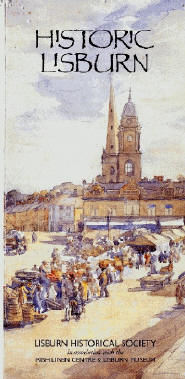 Lisburn Historical Society was established in 1967, through the
support of Lisburn Borough Council and at the request of the Chamber
of Commerce, 'because of the interest in the history of their town and
in the preservation of their historic borough'. The Society has met
this aim by organising talks by experts, excursions, encouraging the
preservation of historic buildings and by 'building a collection of
items of local interest or otherwise, books, documents and pictures or
kindred objects'. In 2000, the collection which had been built up over
the years to consist of almost one thousand items, was donated to the
Council for safe keeping and display in the Irish Linen Centre &
Lisburn Museum.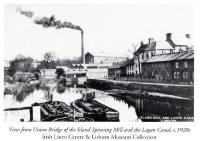
The Society has a programme of monthly lectures by visiting
speakers during the winter months. In the summer season, outings are
arranged to places of historical interest, both locally and further
afield. There are currently over one hundred members and visitors and
new members are always. welcome to the meetings, which are held on the
first Wednesday of each month between September and April.
Further information about Lisburn Historical Society and the
current programme of meetings is available from the Reception staff at
the Irish Linen Centre & Lisburn Museum, Market Square, Lisburn BT28
1AG. Tel. 028 9266 3377.
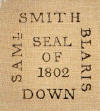 Lisburn, in the parish of Blaris, is situated close to the river
Lagan. Its name in Irish is Lios na gCearbbach or Lisnagarvey,
meaning `fort of the gamesters', a reference to the number of
defensive hill forts in the area in early medieval times. Lisnagarvey
continues to be used in the names of local sports teams.
In 1611 James I granted the lands of Killultagh in south west
Antrim to Sir Fulke Conway who had fought for the Earl of Essex in the
King's campaign against the O'Neills. During the 1620s, Conway laid
out Market Square, Castle Street, Bridge Street and Bow Street as we
see them today and encouraged settlers from his estates in
Warwickshire and Wales. A manor house, known as Lisburn Castle, was
built for the Conways as well as a church and a market house.
During the 17th and early 18th centuries two other groups, the
Huguenots, fleeing religious persecution in France, and the Quakers,
members of the Society of Friends in England, came to Lisburn. Their
skills and commercial experience provided distinctive contributions to
the prosperity and growth of the linen trade in 18th century Lisburn.
In the 19th and 20th centuries, Lisburn's central location in the
Lagan Valley was enhanced by canal, rail and road connections. The
Industrial Revolution brought mills and factories and Lisburn became
renowned for linen manufacture as well as trade. The descendants of
Fulke Conway, the Hertfords and Sir Richard Wallace, continued to
exert their influence. In the 21st century Lisburn continues as a
bustling market town, its citizens conscious of their distinctive
civic heritage and the importance of preserving it for the future.

- Market House and Assembly Rooms
The Irish Linen Centre & Lisburn Museum is housed in the former 17th
century Market House. During the 18th century an elegant upper floor
Assembly Room was added and the building continued as a civic
meeting place in the 19th and 20th centuries. Lisburn Museum was
founded in 1979 and expanded into its present form in 1994 with the
opening of the Irish Linen Centre.
- Lisburn Cathedral
The church of St Thomas was founded in 1623 and was granted
cathedral status by Charles II in 1662. The present building dates
from reconstruction following the town fire of 1707. It contains
memorials to prominent citizens, including two stained glass windows
to the memory of Sir Richard Wallace and a wall tablet to Bishop
Jeremy Taylor.
- Castle House
Built in 1880 as the private residence of Sir Richard Wallace
(1818-90), a descendant of the Conway family who were the 17th
century landlords of Lisburn. Wallace's name is remembered in
Wallace, High School, Wallace Park and as a patron of the arts,
whose collection forms the Wallace Collection in London. Castle
House is now part of Lisburn Institute.
- Castle Gardens
This is now a public park and was formerly the gardens and grounds
of Lisburn Castle, which was built in the 1620s by Sir Fulke Conway.
Part of the original Jacobean boundary stonework remains, with a
datestone of 1677.
- Wallace Fountains
Situated in Market Square and Castle Gardens. Sir Richard Wallace
was resident in Paris during its siege in the France-Prussian War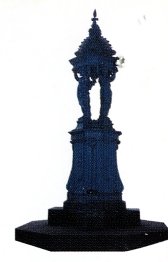 of 1870-71. He erected fifty drinking fountains in Parisian streets
to provide clean drinking water for the people of Paris, a number of
which still remain today. Five fountains were also presented to
Lisburn, of which only two remain.
of 1870-71. He erected fifty drinking fountains in Parisian streets
to provide clean drinking water for the people of Paris, a number of
which still remain today. Five fountains were also presented to
Lisburn, of which only two remain.
- First Lisburn Presbyterian Church
One of the earliest Presbyterian congregations in Ireland, the
present church was built in 1768 and was enlarged and remodelled in
the mid-nineteenth century. It was formerly located behind
properties in Market Square which were demolished in 1970 for a new
extended frontage and porch.
- Seymour Street Methodist Church
Opened in 1875 on a site given by Sir Richard Wallace, this red
brick church in Venetian gothic style replaced the old Methodist
church in Market Street where John Wesley had preached.
- St Patrick's Roman Catholic Church
Erected in 1900 on the site of all earlier church of 1786. In the
entrance is a memorial to the Very Rev. Mark McCashin who initiated
the construction of the church. The first burials in the graveyard
behind the church date from 1850.
-
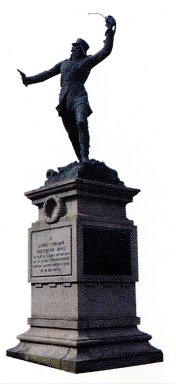 Statue
of Brigadier General John Nicholson (1821-57) Statue
of Brigadier General John Nicholson (1821-57)
Nicholson, a Lisburn man, was commissioned in the Bengal
Infantry in 1839, and fought in the First and Second Sikh Wars in
the 1840s and 1850s. During the Indian Mutiny of 1857 he took charge
of the assault on Delhi and was mortally wounded. The statue by
Pomeroy was placed in Market Square in 1922
- Hilden
A former mill village with 19th century terraced housing for the
workers employed by the linen thread manufacturers, William Barbour
& Sons, founded in 1784.
- Drumbo
From the Irish, Druim Bó,
meaning 'ridge of the ox'. In the Presbyterian church yard is the
surviving stump of a round tower c. 12th century AD.
- Hillsborough
A Georgian village, developed by Wills Hill, 1st Marquis of
Downshire (1718-1793). The former Hill family residence,
Hillsborough Castle, is now the residence of the Secretary of State.
The parish church was completed in 1772. Sir Hamilton Harty
(1879-1941), composer and conductor of the Hallé
Orchestra, was the son of the organist.
- Moira
From the Irish Magh Rath, meaning 'plain of the fort'. A
small 18th century market town developed by the Rawdon family. The
parish church was built in 1723. Moira Railway Station dates from
1841 and is the earliest surviving station building in Ulster.
- Middle Church. Ballinderry
Built under the direction of Jeremy Taylor, Bishop of Down, Connor
and Dromore, chaplain to Charles I, and noted Anglican scholar, the
church was consecrated in 1668 and remains a good example of a 17th
century Church of Ireland parish church.
Ulster Star
21/04/2005 |

